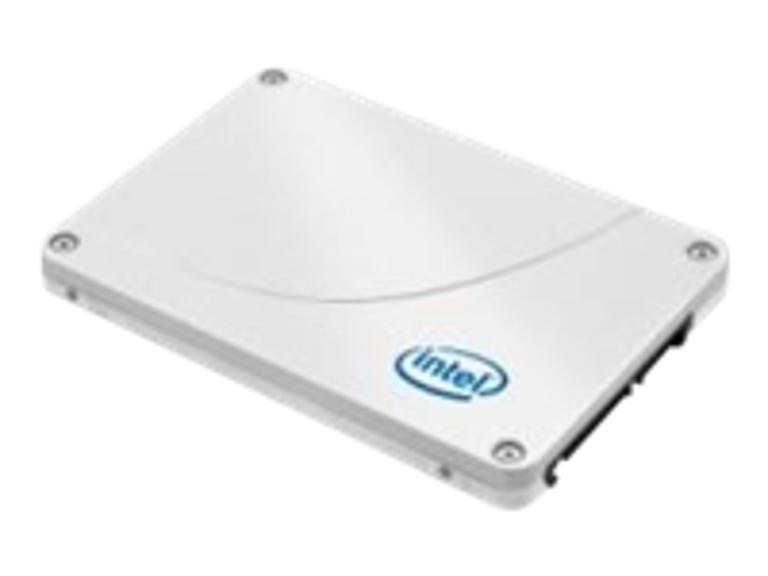 Why You Can Trust CNET
Why You Can Trust CNET Intel Solid-State Drive 520 review: Intel Solid-State Drive 520
Intel Solid-State Drive 520
The 2.5-inch standard Intel 520 Series SSD comes with the same SandForce controller as many others on the market but with special firmware, version 400i, developed by Intel to improve performance. And the drive for the most part delivered, offering very fast performance in my testing. The drive's also aesthetically pleasing and rugged with an all-aluminum casing, and comes with all you need to install it in a desktop computer.
The Good
The Bad
The Bottom Line
The only complaint I have about the drive is the pricing, which is about $2 per gigabyte, making it one of the most expensive solid-state drives (SSDs) on the market. If you can live with that, the 520 Series will make an excellent hard-drive replacement, especially for ultraportable laptops and desktops, thanks to its 7-mm thickness option and included accessories.
If you want something of similar quality and slightly better performance but costing less for your standard laptop, however, I'd recommend the Samsung 830 Series.
Design and features
| Drive type | Internal drive |
| Connector options | SATA 3 (6Gbps), SATA 2, SATA |
| Available capacities | 60GB,120GB, 180GB, 240GB, 480GB |
| Product dimensions | 7mm and 9.5mm thick, 2.5-inch standard |
| Capacity of test unit | 480GB |
| OSes supported | Windows, Mac, Linux |
The Intel 520 Series SSD is a special solid-state drive. For one, it's only 7 millimeters thick, whereas the standard SSD thickness is 9.5mm. This is basically another push of Intel to promote its ultrabook campaign. To make it also fit in a standard 9mm, 2.5-inch hard-drive bay, the drive comes with a frame piece on top that adds another 2.5mm. This piece can be taken off, but then you will need four shorter screws to keep it in the 7mm design. These screws are unfortunately not included, but they seem to be standard screws that you might be able to find at a hardware store.
The second rather unusual aspect of the drive's design is the fact that its housing is made entirely of aluminum, making it both attractive and sturdy. And finally, the drive comes with all the accessories you'd need to use it with a desktop computer, including a SATA cable, a Molex-to-SATA power cable, a 3.5-inch mounting bracket, and mounting screws.
The 520 Series will work in any SATA application, including most ultraportable laptops, all standard laptops, and all desktops. To make it an easy replacement for a hard drive, Intel also provides free data migration software, which is a rebranded version of Acronis True Image that helps make moving the entire existing system to a new drive easier.
While the drive uses a SandForce controller, it comes with Intel's new 400i firmware designed to offer much better performance than other drives with the same controller. The drive supports SATA 3 (6Gbps) but will work with the original SATA (1.5 Gpbs), SATA 2 (3Gbps), and SATA 3 (6Gbps). To get its top performance, you should use it with a computer that supports SATA 3.
According to Intel, the new drive support AES 256-bit data encryption. I tried with different platforms and different RAID setups and it worked well with all of them. Like all SSDs, the 520 Series can handle shocks and uses much less energy than a traditional hard drive. The drive is available in 60GB, 120GB, 180GB (unusual), 240GB, and 480GB capacities.
Cost per gigabyte
On average, all capacities of the 520 Series cost around $2 per gigabyte, similar to the recently reviewed RunCore Pro V Max. This is comparatively expensive among SSDs currently on the market. The OCZ Octane, for example, costs around $1.50 per gigabyte, while the Samsung 830 Series, which offers slightly better performance, costs just around $1.70 per gigabyte. To be fair, the 520 Series offers more with its 7mm thickness option and all the accessories as well as utility software. Still it'd be ideal if the drive cost $1.50 per gigabyte or less. Hopefully its price will get lowered.
Performance
Though not the fastest I've seen, the Intel 520 Series SSD did well in my testing, helping the host computer take just 12 seconds to boot and about 6 seconds to shut down. These numbers are on par with other SSDs I've seen.
While it's hard to put this in numbers, the drive also helps boosts application performance a great deal. This means an application that would normally take a while to load from a hard drive loads much more quickly from an SSD. With the 520 Series, this was especially true for games. StarCraft 2, for example, took just a few seconds to load in my trials, an improvement I personally really appreciated.
The Intel 520 Series SSD also showed some impressive numbers for sequential writing and reading. When used as a secondary drive, where the 520 Series performed only the writing, it managed about 230MBps, putting it among the top four on the chart. When used as the main drive hosting the operating system and thus both writing and reading at the same time, it still scored 154MBps, among the top three.
(Shorter bars indicate better performance)
(Longer bars indicate better performance)
Service and support
Intel backs the 520 Series with a serious five-year warranty. This is the top warranty that you can expect, since most SSDs come with just a three-year warranty or less. On Intel's Web site, you'll find a section dedicated to the drive, where you can find more information and download software for it.
Conclusions:
Despite the hefty price tag, the Intel 520 Series SSD makes an excellent hard-drive replacement for any computer on any platform.


